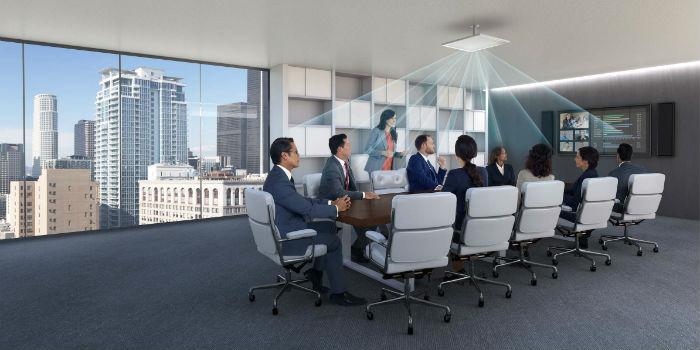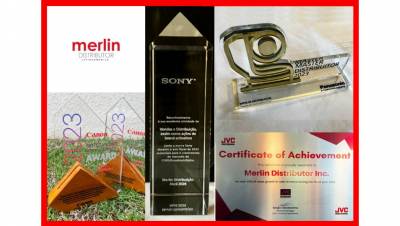 Microphone manufacturers want the wireless systems that are distributed to each country to be under the references that each government defines for radio frequency. That's why it's important to shop at the local market.
Microphone manufacturers want the wireless systems that are distributed to each country to be under the references that each government defines for radio frequency. That's why it's important to shop at the local market.
By Richard Santa
In Mexico City is located the multinational insurance company Mapfre, a tower 124 meters high, with 27 floors and five underground floors. This building has an auditorium for 150 people and a private conference room for executives.
Precisely for these last two spaces, the company required to actulize the audio technology and decided to install wireless microphones with which they overcame the congested radio frequency environment of Mexico, an easy installation and offer reliability.
Wireless microphones are a solution that has been growing strongly for use in corporate meeting rooms in Latin America. The facilities to couple these systems to the designs help to avoid the common problems with architects and designers. In addition, the built-in technology makes it easy to install and use.
To learn more about the correct installation of these systems and their applications, AVI LATINOAMÉRICA spoke with Guilherme Steinhauser, Market Development Specialist for Integrated Systems at Shure, who has participated in the installation of this technology in different projects in the region.
He stressed that the main thing that must be taken into account when choosing a wireless microphone system is that the equipment is purchased from a certified distributor and that it is approved for the references in each country. The biggest problem that wireless microphones have is the radio frequency on which they will work and each country chooses the ranges in which it should be located.
"When someone buys a microphone in a country that is not where it is going to be used, they run the risk that it will not work. In some cases, when the equipment does not have the approved frequency or is not in the range of available frequencies, the microphone may be lost. There is the possibility of sending it to the factory, but it is an additional cost and the cheap ends up being expensive, "he said.
Wireless microphone environment
The Shure specialist pointed out that radio frequency is the fundamental factor for the operation of a wireless system. The corporate world, in which meeting rooms are used more, is located in some areas that have many cell phone, television and radio antennas, which leaves a very small frequency strip to work.
That's why wireless systems are not plug and play. You must have trained personnel who are responsible for performing a sweep before installing the equipment to define what is the best frequency in the area.
"One of the advantages of wireless microphones is that it's all connected to the network. For its operation, companies must have a good data network. Once online, it can be integrated with any AV system, even analog systems. It can also be integrated with codecs and any digital equipment. There is nothing that cannot be integrated into a conference room today," said Guilherme Steinhauser.
To be taken into account
Our guest highlighted three points that he believes should be taken into account to achieve a correct installation and operation of wireless microphone systems:
1. Understand how end users will work in meeting rooms. If it is a room that simply uses the microphone to pick up the voice and magnify it, or if it is a room that has video conferencing.
2. Who are the users to define the conditions of the installation.
3. Analyze the acoustics of the room and the external noise that may affect.
He mentioned that "These points are not taken into account in 50% of the facilities. People want a recipe, like saying that a 2x2 room requires a microphone, a 4x4 room two microphones, or something like that. But this doesn't really exist. You must start from an evaluation and from there begin to determine the amount and which microphones. There are parameters but they don't work like a recipe. Every project is unique and special, every room is different from the other, so you must go step by step to think about the audio capture in each room".
Use in Latin America
According to Guilherme Steinhauser, wireless microphones in conference rooms are being used a lot in the region, because the tables are clean, which allows the format of the room to be easily moved. In addition, architects do not like that the rooms are full of devices, so they prefer wireless technology
Today the newest microphones have encrypted radio frequency transmission, which makes them very secure. Many companies didn't like to use them because someone could get into the frequency and listen to what was being talked about. But already the risk has been minimized with the built-in security in the microphones.
Results in the Mapfre tower
Considering Mexico's current transition to high-definition television, dealing with digital and analog TV channels simultaneously, and the licensing of the 700 MHz band to communication services, the radio frequency landscape was the biggest concern when choosing audio equipment for Mapfre.
The company's auditorium today operates with three MXWAPT8 access point transmitters and a four-channel MXWAPTA access point transmitter-receiver to ensure frequency clarity in wireless transmitter microphones. There are four MXW8 gooseneck base transmitter microphones on stage and 20 MXW6/C surface wireless transmitter microphones distributed in the audience seats for questions to be asked.
For presenters who need to move around the stage, four MXW1 hybrid body transmitters with internal microphones are available. There are also two ULX-D® digital wireless systems with an MX153 headband subminiature microphone and an MX150 subminiature lapel microphone to meet the presenter's preferences.
The conference room, used for high-level executive meetings, has a smaller facility and features an MXWAPT8 access point transmitter located in the ceiling of the room and an MXWAPTA access point transmitter-receiver to complement the transmitter.
Shure Technology
In 2013 the company Shure presented its line of wireless microphone Microflex, under the reference MXW. And at the last version of infoComm Show in Las Vegas, they presented the dual-channel update, which was designed for use in smaller spaces such as university classrooms, small conference rooms and video conferencing applications.
Shure technology has the advantage that microphones are directional. The MXA 910 reference has 100 microphones inside, with which lobes can be created by directing the capture of sound to a single place. In addition, you can have default settings for the different uses of the room and it is very easy to handle. And to control them, the technician does not require to be inside the room listening to what is said in the meeting.
According to Guilherme Steinhauser, when choosing between the new references of ceiling or table microphones for meeting rooms, the main factor to take into account is the size of the room. The tabletop microphone has four lobes aimed at rooms of maximum 4 or 6 people. It has a circular pattern by which the sound that comes from the top, from the ceiling, like the air conditioning, does not capture it, only those that are around.
The ceiling microphone, because it has eight lobes, can direct the sound to be picked up to one or more people in a previously determined place.


























Leave your comment